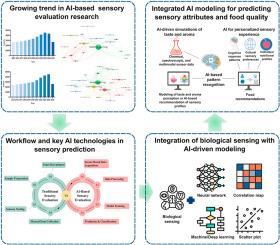人工智能在食品感官评价中的应用
IF 15.4
1区 农林科学
Q1 FOOD SCIENCE & TECHNOLOGY
引用次数: 0
摘要
人工智能(AI)正越来越多地融入食品科学的感官评估,以克服传统方法的局限性,如主观性、可变性和对人类面板的依赖。通过整合来自化学分析、成像和消费者反馈的数据,人工智能可以对感官属性(包括味道、香气、质地和外观)进行更客观、可重复和可扩展的评估。范围和方法本文综述了人工智能在食品感官评价中的应用。它包括关键的人工智能技术,如机器学习、计算机视觉、自然语言处理和智能传感器,以及它们在预测、模拟和个性化感官属性方面的作用。强调了通过数据驱动建模、多模态集成和数字仿真对感官分析的人工智能转换。此外,还讨论了与在感官科学中采用人工智能相关的伦理和技术挑战。ai通过将分析数据与消费者的感官反应联系起来,实现了人类感官知觉的高级建模。机器学习和深度学习有助于感官特征的预测分析;计算机视觉和电子传感技术复制人类的视觉和化学感知;自然语言处理提供了消费者生成内容的洞察力。这些技术还支持实时、个性化的感官体验。虽然人工智能为食品设计和评估创新提供了强大的工具,但必须解决数据质量、模型透明度和道德使用等问题。这篇综述强调了跨学科合作的必要性,以确保基于人工智能的感官系统的包容性、可解释性和以人为本的发展。本文章由计算机程序翻译,如有差异,请以英文原文为准。

Application of artificial intelligence in the advancement of sensory evaluation of food products
Background
Artificial intelligence (AI) is increasingly being integrated into sensory evaluation in food science to overcome limitations of traditional methods such as subjectivity, variability, and dependence on human panels. By incorporating data from chemical analysis, imaging, and consumer feedback, AI enables more objective, reproducible, and scalable assessments of sensory attributes, including taste, aroma, texture, and appearance.
Scope and approach
This review provides a comprehensive overview of AI applications in the sensory evaluation of food products. It includes key AI technologies, such as machine learning, computer vision, natural language processing, and intelligent sensors, and their roles in predicting, simulating, and personalizing sensory attributes. AI transformations of sensory analysis through data-driven modeling, multimodal integration, and digital simulation are highlighted. Additionally, ethical and technical challenges associated with the adoption of AI in sensory science are addressed.
Key findings and conclusions
AI enables advanced modeling of human sensory perception by linking analytical data with consumer sensory responses. Machine learning and deep learning facilitate predictive analysis of sensory traits; computer vision and e-sensing technologies replicate human visual and chemical perception; and natural language processing provides insights from consumer-generated content. These technologies also support real-time, personalized sensory experiences. While AI presents powerful tools for innovation in food design and evaluation, issues such as data quality, model transparency, and ethical use must be addressed. This review emphasizes the need for interdisciplinary collaboration to ensure inclusive, explainable, and human-centered development of AI-based sensory systems.
求助全文
通过发布文献求助,成功后即可免费获取论文全文。
去求助
来源期刊

Trends in Food Science & Technology
工程技术-食品科技
CiteScore
32.50
自引率
2.60%
发文量
322
审稿时长
37 days
期刊介绍:
Trends in Food Science & Technology is a prestigious international journal that specializes in peer-reviewed articles covering the latest advancements in technology, food science, and human nutrition. It serves as a bridge between specialized primary journals and general trade magazines, providing readable and scientifically rigorous reviews and commentaries on current research developments and their potential applications in the food industry.
Unlike traditional journals, Trends in Food Science & Technology does not publish original research papers. Instead, it focuses on critical and comprehensive reviews to offer valuable insights for professionals in the field. By bringing together cutting-edge research and industry applications, this journal plays a vital role in disseminating knowledge and facilitating advancements in the food science and technology sector.
 求助内容:
求助内容: 应助结果提醒方式:
应助结果提醒方式:


